Top News
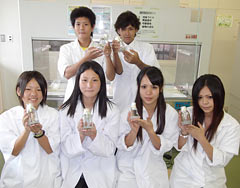
July 13, 2012 Ryukyu Shimpo
Ten students majoring in horticultural engineering at Hokubu Agricultural High School, have succeeded in sterile cultivation of the Easter lily. They launched the project last year with the aim of increasing the numbers of this flower that symbolizes Nago but is losing its hold in the wild. The strain grown in a sterile culture has a high probability of taking root in a natural environment. Koji Miyoshi, who teaches the students, stated, “This project marks the first step towards restoring the original landscape of Nago.”
The students collected some of the flower bulbs from the wild, and made the lilies produce buds using the school’s disinfection equipment. The lily family of plants is known to have viruses and struggles to take root in a natural setting because the leaves of the infected bulbs die down, producing fewer petals.
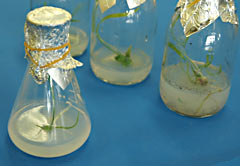
The Easter lily strains cultivated under sterile conditions.
As a result of testing seven bulbs, including the strains cultivated at the school, flowers growing naturally in Nago, and garden species, the students confirmed that the strains cultivated in a sterile environment did not have any viruses while others did.
In future, the project aims to increase the number of the lily strains cultivated in a sterile environment. The project will take several years to complete because it needs to establish the technique of allowing the strain to proliferate in sterile conditions, and make the bulbs grow. After the students currently working on the project graduate from the school, the younger students will take over. If the project succeeds in increasing the number of bulbs, they will be distributed to residents’ associations and elementary schools, which will then contribute to restoring the exuberance of blooming Easter lilies to the scenery of Nago.
Daiki Maeda, one of the students, said, “It was difficult to sanitize the incubator and prevent viruses from spreading. I look forward to the younger students to take over the project. I will be glad if I can see more Easter lilies blooming in Nago.”
Many Easter lilies used to grow along the road called Nanamagari that runs from Kyoda to Agarie in Nago, coloring the slopes white. The number of Easter lilies has decreased due to road maintenance and improvement. The Nago municipal authorities and volunteer groups are planting the flowers.
(English translation by T&CT, Mark Ealey)
Go to Japanese
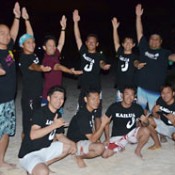
July 6, 2012 Ryukyu Shimpo
In preparation for Moon Beach Luau 2012, a Hawaiian event to be held on July 7 and 8 at the Hotel Moon Beach in Onna, several men have been practicing the hula dance. The Kailua Hula Studio, based in Kubota, Okinawa City is unique in that they have ten male dancers.
A member of the team said, “The overwhelming majority of hula dancers are female, but we want to encourage male hula from Okinawa.”
Ten men and 13 women, a total of 23 people have been practicing at the Kailua Hula Studio.
At events in July, these male dancers will perform in two of three performances by themselves.
In the last three years, Daiki Nakamoto, who is one of the key members of the team, has made several trips between Okinawa and Hawaii to learn hula. Last November, he invited Ariyuki Tamanaha, a firefighter and former colleague and others to give it a go. Tamanaha explained the merits of hula for him as being that he could enjoy it with his wife.
To get ready for the live performance, on June 26 they practiced at Araha Beach in Chatan. “I want to entertain the audience with a dynamic performance that only male dancers can achieve.” Nakamoto said.
(English translation by T&CT, Lima Tokumori and Mark Ealey)
Go to Japanese

July 5, 2012 Eriko Tamaki of Ryukyu Shimpo
Sachika Kinjo, a girl born this January weighing just 407 grams left the Okinawa Prefectural Chubu Hospital on July 3. Even for the hospital specializing in treatment for the most critically ill baby-patients, a baby weighing only 407 grams required intensive care. It was said that there was no guarantee that she would survive for very long after birth, but she grew to 2990 grams in weight and 45 centimeters in body length. Her parents have sensed her vitality and the preciousness of life, and owe a debt of gratitude to the medical staff who helped maintain this tiny life.
Sachika’s mother, Natsuko, gave birth to her baby 16 weeks early when she was hospitalized for pregnancy-induced hypertension.
The doctor told Yukito, the father of Sachika, that he doesn’t know if he can help Sachika because she was born too early and too small. When the parents saw Sachika in the newborn intensive care unit, she was so small that she could be held in the palm of an adult hand and was hooked up to many tubes. Natsuko felt sorry for the baby and blamed herself.
Sachika underwent heart surgery nine days after she was born, and at one stage her weight decreased to just 367 grams, but she then grew steadily thanks to the careful nursing treatment that she received. She still needs domiciliary oxygen therapy for some time to supplement her lung function, but has no other medical issues.
Natsuko went to the hospital every day from her family home in Onna to breast-feed her baby daughter. She said, “The nurses and doctors provided such tender care for us as parents feeling so depressed about the situation.” Sachika has to live at Natsuko’s family home, so that the day when the family can live together on Ie-jima, where their home is located, has been postponed to a later date. Yukito said, “I am still worried, but people back on the island have been waiting for us. I hope we can return to the island together soon,” and he smiled.
The vice-chief of the Pediatric Department, Ryuichi Genkawa, who is looking after Sachika, explained that after they check out of the hospital, cooperation, including that from the community is vital for the development and treatment of premature babies.
(English translation by T&CT, Lima Tokumori and Mark Ealey)
Go to Japanese

July 4, 2012 Ryukyu Shimpo
On July 1, a feed-in tariff energy system commenced. This is a system that requires utilities to purchase all of the electricity generated by renewable-energy sources such as wind and the sun and pay a fixed-price to those who generate renewable electricity generators. In Okinawa, there are moves to set up distributed solar power generation with decentralized mega-solar plants, which are large-scale photovoltaic generating facilities that allow for electricity power purchase businesses to rent roof space. An association will also be set up to oversee this. Demand for ground-mounted solar panels on unused land is also increasing. Japan has lagged behind other developed societies in the use of renewable energy, but it expects the use to increase. However, there are also some challenges ahead.
While some municipalities have begun to promote the installation of solar power units by renting roofs of houses and apartments, the solar panel construction and sales company Nissin Holdings is the first to start an electricity power purchase business in Okinawa involving the leasing of roofs on housing.
At Sunabe in Chatan, 42 units of 230-watt solar power panels were installed on roofs of housing leased to Americans. On the first day when the electricity purchased from leased roof space started in early June, the output of solar power generation was far higher than electricity power consumption. President of Nissin Holdings, Sadao Tsukayama, said, “The real future-oriented business starts from this point.”
A solar power panel system on a house has a capacity to generate 9.66 kilowatts. The company will buy surplus electricity from households, with the initial approach being for full purchase at a fixed price. Nissin Holdings plans to set up 50 ten-kilowatt size solar panels in similar residential areas and will analyze the generation efficiency and other management issues.
The company will apply to the Ministry of Economy, Trade and Industry soon to set up 50 sets of panels for total purchase of the electricity generated from them. The project is expected to cost approximately 200 million yen if the roofs of all the houses are leased out. Nissin Holdings will pay an amount of rent to owners of the roof space equivalent to about 5% of the electricity for sale. They aim to set up a decentralized solar power generation system involving the installation of mega-solar plants. Once the certification is complete, they will phase in the installation of 100 panel systems in the area.
On June 20, Nissin Holdings established a subsidiary company called Sun Progress to look after the maintenance and management of the system. Sales manager, Toru Oshiro, said, “With a 20-year period for the feed-in tariff energy system, it is important that the system can still be running effectively to generate energy in ten to 15 years time.”
(English translation by T&CT, Megumi Chibana and Mark Ealey)
Go to Japanese
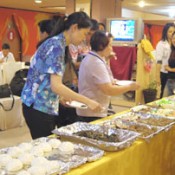
July 5, 2012 Ryukyu Shimpo
At Taiwan’s largest international food show held at the end of June, there were many new orders taken for goods such as mozuku. The largest number of companies from Okinawa to date, 17 in total, participated in the event and initiated 1032 business discussions. Among them, 18 business negotiations were concluded for a value of approximately 6.4 million yen, and another 80 are expected to close negotiations involving more than 140 million yen. The Naha-based trading company Arakaki Tsusho, received an order from a Japanese restaurant in Taipei for 500 kilograms a month of raw mozuku, a type of edible seaweed found around Okinawa. They also are discussing the potential for snacks made from mozuku.
Working with the Okinawa Prefectural Fisheries Cooperative, Arakaki Tsusho has searched for ways to take mozuku into the overseas market. Since March, they have been trying to find dishes acceptable to the Taiwanese palate in order to find ways to sell mozuku there. Arakaki Tsusho has prepared a brochure for the exhibition event, and in addition to using the term “Okinawan mozuku,” in attempt to appeal to the health-conscious Taiwanese, they have also applied for a trademark for the name “long-life seaweed.”
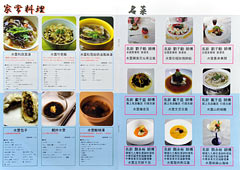
Arakaki Tsusho prepared a brochure to introduce recipes of mozuku at “Food Taipei 2012.”
Arakaki Tsusho, which to date has mainly engaged in the trade of miscellaneous goods, has started talks about exporting raw
mozuku. Harvesting
mozuku produced in Okinawa, and controlling costs will be crucial issues for them. A company representative said, “To start with, an order of one ton of
mozuku was discussed. We hope that this will trigger the start of ongoing business.”
At the exhibition event, Hamashoku Co. Ltd., of Okinawa City, which already exports dried mozuku to Taiwan, Hong Kong, and the United States, also received an order for 1000 ten-gram bags of dried mozuku, an amount representing 5% of the average annual volume exported to Taiwan. They also are negotiating to secure an order for 10000 bags. The company has also received an order for 2000 units of 500-milligram bottles of Fucoidan ekisu, the essence of mozuku, from a trading company in Kaohsiung in Southern Taiwan that takes 10% of the annual exports. These products will be shipped in August.
The food show called “Food Taipei 2012” was held from June 27 to 30, attracting food manufacturers and buyers from all over the world. The Japan External Trade Organization set up a “Japan Booth” and 67 companies from all over Japan participated, the largest number to date.
(English translation by T&CT, Megumi Chibana and Mark Ealey)
Go to Japanese

July 5, 2012 Ryukyu Shimpo
On the night on June 4, in Taira on Ikema-jima, north of Miyako-jima, a species of terrestrial crab known as okagani was observed spawning. The crabs moved down towards the sea in the moonlight with eggs about to hatch stuck on their bellies.
Every year around the time of the full moon on May 15 in the old lunar calendar it is normal to observe the spawning of such crabs on Ikema-jima, where the distance between the wetland and the seashore is relatively short. At sunset, at around 7:00pm on July 4, which is May 15 in the old lunar calendar, the crabs started to move and crossed the road that runs around the island.
The crabs managed to get to the sea to shake their bodies in tune with the movement of the waves, spawning their progeny.
Juna Taira of Ikema Elementary School watched the crabs spawn, saying,“I come to watch the crabs spawn every year, but this year I am glad to be able to watch them close up with so many big ones in there.”
(English translation by T&CT, Mark Ealey)
Go to Japanese

July 4, 2012 Akiko Yasuhara Correspondent of Ryukyu Shimpo
On June 24, at the Brazil Okinawa Cultural Center in Sao Paulo, a discussion involving first-generation Okinawan Brazilians was held to mark the 40th anniversary of the reversion of Okinawa to Japanese sovereignty and to deepen the understanding of Okinawa, which was under the U.S. military occupation. According to the Brazil Okinawa Kenjin-Kai, this is the first event held in Brazil to commemorate the 40th anniversary of Okinawa reversion.
One of the organizers of the discussion, Satomi Matsumoto, who is a student and third-generation Okinawan Brazilian, explained that when she first visited Okinawa four years ago she was shocked at the serious nature of the U.S. military bases issue. She said that the popular image of Okinawa in Brazil is of its culture and beautiful sea, saying, “Many young Okinawan Brazilians don’t know the history of Okinawa under U.S. occupation or anything about the base issues. I wanted to create an opportunity to share information about these things.”
In the discussion, five first-generation Okinawan Brazilians who moved to Brazil during the postwar years explained aspects of Okinawa under U.S. military occupation. Alice Tarama, who was ten years old when the war ended, spoke of how she accepted food from U.S. military in order to survive, saying, “I want young people to understand the history of Okinawa and the misery of war.”
In addition to the discussion, a photo exhibition of Okinawa before the reversion was held and there were approximately 50 visitors. Keiko Nakamatsu, who is third-generation Okinawan Brazilian, said, “I knew something about the base issue in Okinawa, but now I would like to know more about it.”
(English translation by T&CT, Lima Tokumori and Mark Ealey)
Go to Japanese
July 3, 2012 Ryukyu Shimpo
On July 2 government officials reported that the cargo ship carrying the MV-22 Osprey vertical take-off and landing transport aircraft, which will be deployed at U.S. Marine Corps Air Station Futenma, departed from San Diego, California, and is heading for U.S. Iwakuni base, in Yamaguchi Prefecture. The Osprey aircraft will temporarily stay at the Iwakuni base. After the cargo ship carrying a dozen of the aircraft passes through Hawaii, it will arrive at the Iwakuni base in late July.
Members of Rimpeace, a citizens’ group that monitors the movement of U.S. forces in Japan, speculate that the cargo ship Green Ridge carrying the Osprey aircraft that departed from the North Island Naval Base, San Diego on July 1. The next port call for the cargo ship will be Hawaii. The Green Ridge operates between the West Coast of the United States and Asia-Pacific countries such as Japan and South Korea, and mainly transports materials and equipment for the U.S. military. Its length is 200 meters, its beam is 32 meters and it has a gross tonnage of 57449 tons and a deadweight of 21523 tons.
(English translation by T&CT, Mark Ealey)
Go to Japanese
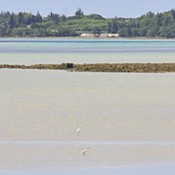
July 4, 2012 Ryukyu Shimpo
Ahead of the 15th meeting of the signatory countries to be held in Bucharest, Romania, commencing on July 6, the Ramsar Convention on Wetlands has added new areas to its list, including Yonaha Bay in Miyako-jima. The Convention on Wetlands, otherwise known as the Ramsar Convention, which was held in Ramsar, Iran in 1971, is an intergovernmental treaty embodying the commitments of its member countries to maintain the ecological character of their Wetlands of International Importance and to plan for the sustainable use of all of the wetlands in their territories. Its secretariat is located in Geneva, Switzerland. Yonaha Bay became the fifth Ramsar site in Okinawa following Manko in Tomigusuku, the Kerama-shoto Coral Reef and Nagura-Ampuru on Ishigaki, streams on Kume-jima.

Made up mainly of three different types of seagrass, the site supports one of the most extensive seaweed beds in the Ryukyu Islands biogeographic region. A significant number of waterbird species, including the critically endangered spoon-billed sandpiper, the black-faced spoonbill, and Saunders’s gull, and the Far Eastern curlew, stop at the site to forage or breed.
According to the list of animals and birds compiled by the Ministry of the Environment, 123 species of birds live on the site. In November 2011, the Japanese government designated Yonaha Bay as a Special Protection Zone.
Miyako-jima mayor Toshihiko Shimoji will attend the ceremony in Bucharest on July 7 and to commemorate this, the Okinawa Prefectural Government will hold a symposium on August 4.
People involved were very pleased that Yonaha Bay has been officially added to the list of Ramsar sites. Shimoji said, “I think that the entire natural environment of Miyako was thought to be marvelous. We hope that the site attracts many birds every year.” In future, the Miyako municipal authorities are considering constructing facilities for bird watchers.
Kunihiro Nakachi, head of the Miyako Wild Bird Association, said, “I think that this achievement will stimulate the people of Miyako to pay greater attention to their natural environment. I hope that they all start to think about helping to protect the site.” Nakachi went on to say, “I am thinking of increasing opportunities for people to watch wild birds in future.”
With its registration in the international treaty, Yonaha Bay is expected to see an increase in tourists. Takamori Ikema, the executive director of Miyako Tourist Association, was delighted at the development, saying, “It may help to enhance the image of Miyako in terms of the Declaration of Eco Island Miyako-jima, and may help the tourism industry here. It might help to attract attention to Miyako-jima.”
(English translation by T&CT, Mark Ealey)
Go to Japanese
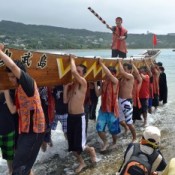
June 26, 2012 Ryukyu Shimpo
On June 23, in the waters off Ojima Island, Tamagusuku in Nanjo, the Watatsumi Festival with its dragon-boat race was held. Many visitors from both on and off the island cheered on the oarsmen.
The main dragon boat race is decided by the outcome of the best of seven races such as Ugan-barley, in which local residents are divided into East and West teams to compete, and the nagare-bune in which the rowers dive off a bridge to start the race. This year, the East team won with five wins and two losses. At each race, the winner’s oarsmen lifted their boat up in a show of joy. After the main dragon boat race, there were races held for people competing in workplace teams.
About 400 years ago, China presented a Kannon statue to the island’s residents as a display of gratitude for their having helped shipwrecked Chinese crews. People began to pray for prosperity on the island, safe journeys at sea and large catches to the Kannon-do temple to which the statue is dedicated, and it is said that this was the origin of the dragon boat races of Ojima Island. Before the main race started, Ward Chief Masatsune Ashitomi prayed at the temple.
(English translation by T&CT, Lima Tokumori and Mark Ealey)
Go to Japanese

June 26, 2012
On June 25, at a press conference held at the Okinawa Prefectural Government Office, the World Youth Uchinanchu Association (WYUA) released the program of the 1st Worldwide Youth Uchinanchu Festival, which will take place in Sao Paulo, Brazil from July 25 to 29.
It is expected that about 150 Okinawans from eight countries such as Brazil, Argentina, Peru, Bolivia, the United States, Germany, China, Japan and Okinawa will participate in the festival.
On the first day, the festival will feature an opening ceremony and dinner party, and on the second day, an exchange program is planned in which participants from each country will divide into 41 groups according to their municipalities of origin, to carry out workshops to study the history of immigrants. In addition, there will be tours to see factories and companies run by Okinawans, and an international conference to discuss how to make use of a sustainable Uchinanchu network. In addition, the Ryukyu Stomp, a dance group formed by the members of the association will perform at a local festival held by the Brazil Okinawa Kenjin-Kai.
Minami Tamamoto, the chairperson of the festival, and also the chairperson of the WYUA in Okinawa, looked back upon the difficulties that she faced when she raised funds for the festival. “Okinawans overseas have the hearts and minds of Uchinanchu, something that the people living in Okinawa do not have. I thought that we must share this, and that drove me into action.”
Sho Miyagi, the public relations manager of the association, commented that there were many Okinawans in Brazil who couldn’t take part in the 5th Worldwide Uchinanchu Festival because they are so far from Okinawa. He therefore thought that it was our turn to visit them. “If this festival succeeds, I believe that we can do well the next time too. I would like to work towards the 6th Worldwide Uchinanchu Festival with Okinawans in all countries.” For further details, call the WYUA at 098-863-2673, or refer to the official website. The website:
http://yuao.org/
(English translation by T&CT, Lima Tokumori and Mark Ealey)
Go to Japanese













 Webcam(Kokusai Street)
Webcam(Kokusai Street)


